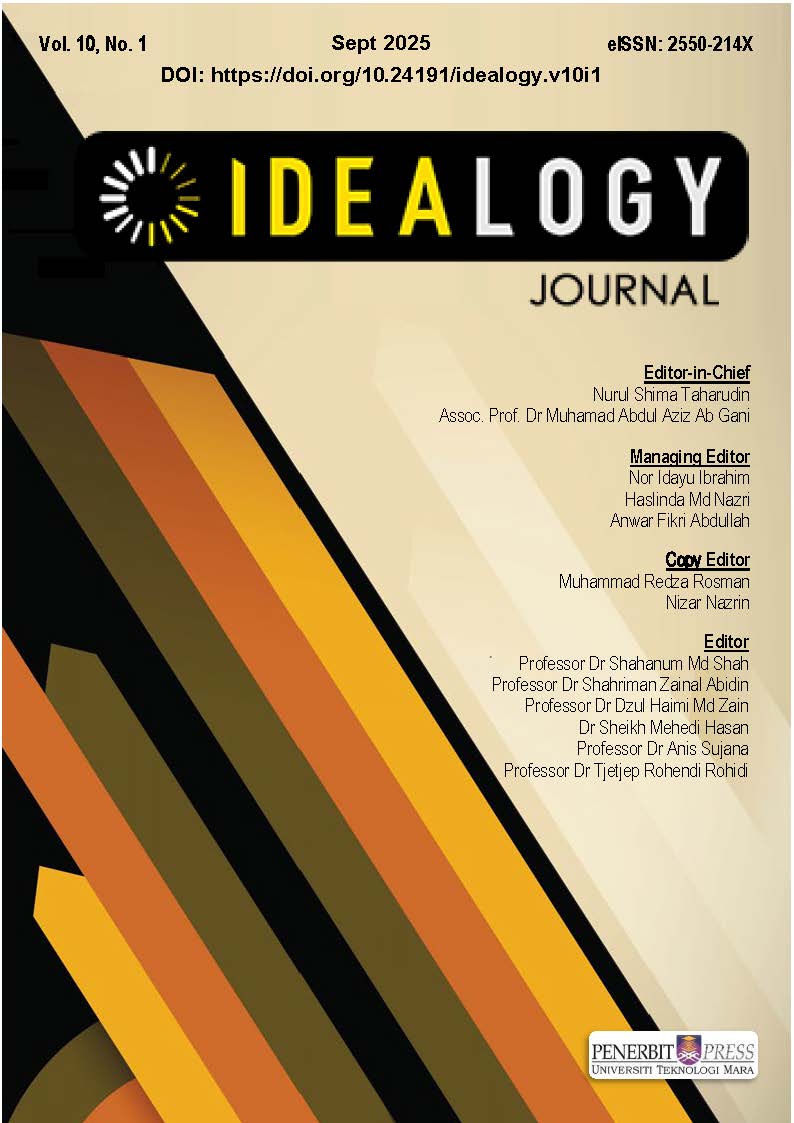CLO3D and Posthumanism: Rethinking the Relationship Between Body, Fabric, and Digital Space in Malaysian Fashion
DOI:
https://doi.org/10.24191/idealogy.v10i1.740Keywords:
Posthumanism, Digital Fashion, CLO3D, Malaysian Cultural Identity, Non-Human AgencyAbstract
This study examines how CLO3D, a 3D fashion design software, reconfigures the relationship between body, fabric, and cultural identity in Malaysia’s fashion industry through a posthumanist lens. By analysing qualitative interviews with six Malaysian designers and visual-textual artifacts from CLO3D projects, the research reveals three transformative dynamics: (1) the emergence of digital corporeality, where non-normative avatars disrupt anthropocentric ideals of the body; (2) distributed agency between human designers and algorithmic tools, challenging traditional notions of authorship; and (3) the hybridization of cultural heritage, as motifs like batik and songket merge with cyber-digital aesthetics. Findings demonstrate CLO3D’s dual role as a decolonial tool for subverting Eurocentric fashion hierarchies and a neoliberal force that risks commodifying cultural symbols. The study highlights tensions between sustainability and digital consumerism, as well as debates over the devaluation of artisanal craftsmanship in virtual workflows. By centering Malaysia’s postcolonial context, this article addresses gaps in non-Western perspectives on digital fashion. It concludes with recommendations for integrating posthumanist frameworks into ASEAN fashion pedagogy, fostering ethical digital preservation of cultural heritage, and advocating for green technologies to mitigate CLO3D’s environmental footprint. This research contributes to broader discourses on technology’s role in redefining identity, materiality, and agency in Global South creative industries.
References
Ahmed, S. (2021). Neoliberalism and the digital commodification of cultural symbols. Global Fashion Studies, 5(3), 112–130.
Barad, K. (2007). Meeting the universe halfway: Quantum physics and the entanglement of matter and meaning. Duke University Press.
Bennett, J. (2010). Vibrant matter: A political ecology of things. Duke University Press.
Betts, L. (2020). Algorithmic agency in fashion design: The role of 3D software in creative workflows. International Journal of Fashion Design, Technology and Education, 13(3), 287– 299.
Braidotti, R. (2013). The posthuman. Polity Press.
Bugg, J. (2021). Digital fashion: The new industrial revolution. Fashion Practice, 13(2), 123–145. Chua, L. (2020). Crafting modernity: Artisanal labour and technology in Southeast Asia. Journal of Material Culture, 25(4), 432–450.
CLO3D. (2023). Virtual fashion design software. https://www.clo3d.com
CREST. (2023). Digital transformation in Malaysia’s fashion industry: Challenges and opportunities.
Collaborative Research in Engineering, Science and Technology.
Deleuze, G., & Guattari, F. (1987). A thousand plateaus: Capitalism and schizophrenia. University of Minnesota Press.
Fletcher, K. (2014). Sustainable fashion and textiles: Design journeys (2nd ed.). Routledge.
Haraway, D. J. (1988). Situated knowledges: The science question in feminism and the privilege of partial perspective. Feminist Studies, 14(3), 575–599.
Hassan, R. (2019). Songket: The royal heritage of Malaysia. Institut Terjemahan & Buku Malaysia.
Ismail, A. (2021). Reimagining Baju Kurung in the digital age: A postcolonial critique. Asian Journal of Cultural Studies, 14(4), 89–105.
Latour, B. (2005). Reassembling the social: An introduction to actor-network-theory. Oxford University Press.
Lee, H. (2022). Digital hanbok: Tradition meets technology. Journal of Asian Design, 9(1), 45–67. MATRADE. (2021). ASEAN digital fashion report: Opportunities for Malaysian designers. Malaysian External Trade Development Corporation.
McKinsey & Company. (2021). The state of fashion 2022: Navigating uncertainty. McKinsey Global Fashion Index.
Ministry of Tourism, Arts and Culture Malaysia. (2022). National craft policy 2022–2030. Government of Malaysia.
Mohamed, N., & Ahmad, S. (2020). Batik digitisation: Preserving Malaysian heritage through 3D technology. Journal of Southeast Asian Arts, 8(1), 22–40.
Quijano, A. (2007). Coloniality and modernity/rationality. Cultural Studies, 21(2-3), 168–178. Said, E. W. (1978). Orientalism. Pantheon Books.
Tan, P. (2022). Digital innovation in ASEAN’s creative industries: A case study of Malaysia and Indonesia. ASEAN Economic Review, 18(2), 75–92.
UNESCO. (2018). Malaysian batik: Safeguarding intangible cultural heritage. UNESCO Publishing.
Downloads
Published
Versions
- 2025-04-01 (2)
- 2025-06-10 (1)
Issue
Section
License
Copyright (c) 2025 UiTM Press

This work is licensed under a Creative Commons Attribution-NonCommercial-NoDerivatives 4.0 International License.
UiTM Press (the Publisher) has agreed to publish the undersigned author’s paper in Idealogy Journal. The agreement is contingent upon the fulfilment of a number of requirements listed below.
1. The undersigned author warrants that the paper entitled below is original, that it is not in any way libellous or unlawful in Malaysia, that it does not infringe any copyright or other proprietary right. The undersigned hereby represents and warrants that he/she is the author of the paper, except for material that is clearly identified as to its original source, with permission notices from the copyright owners where required. The undersigned represents that he/she has the power and authority to sign and execute this agreement.
2. The undersigned author warrants that the paper entitled below has not been published elsewhere, and also it will not be submitted anywhere else for publication prior to acceptance/rejection by this Journal.
3. By submitting the paper entitled below, the undersigned author agrees to transfer the rights to publish and distribute the paper in an international e-journal (entitled above) to Publisher.
4. The undersigned author agrees to make a reasonable effort to conform to Publisher's submission guidelines and to liaise with the editor to ensure that the requirements of these guidelines are met to a reasonable degree.
5. The corresponding author signs for and accepts responsibility for releasing this material on behalf of any and all coauthors. This agreement is to be signed by at least one of the authors who has obtained the assent of the co-author(s) where applicable. After submission of this agreement signed by the corresponding author, changes of authorship or in the order of the authors listed will not be accepted.


